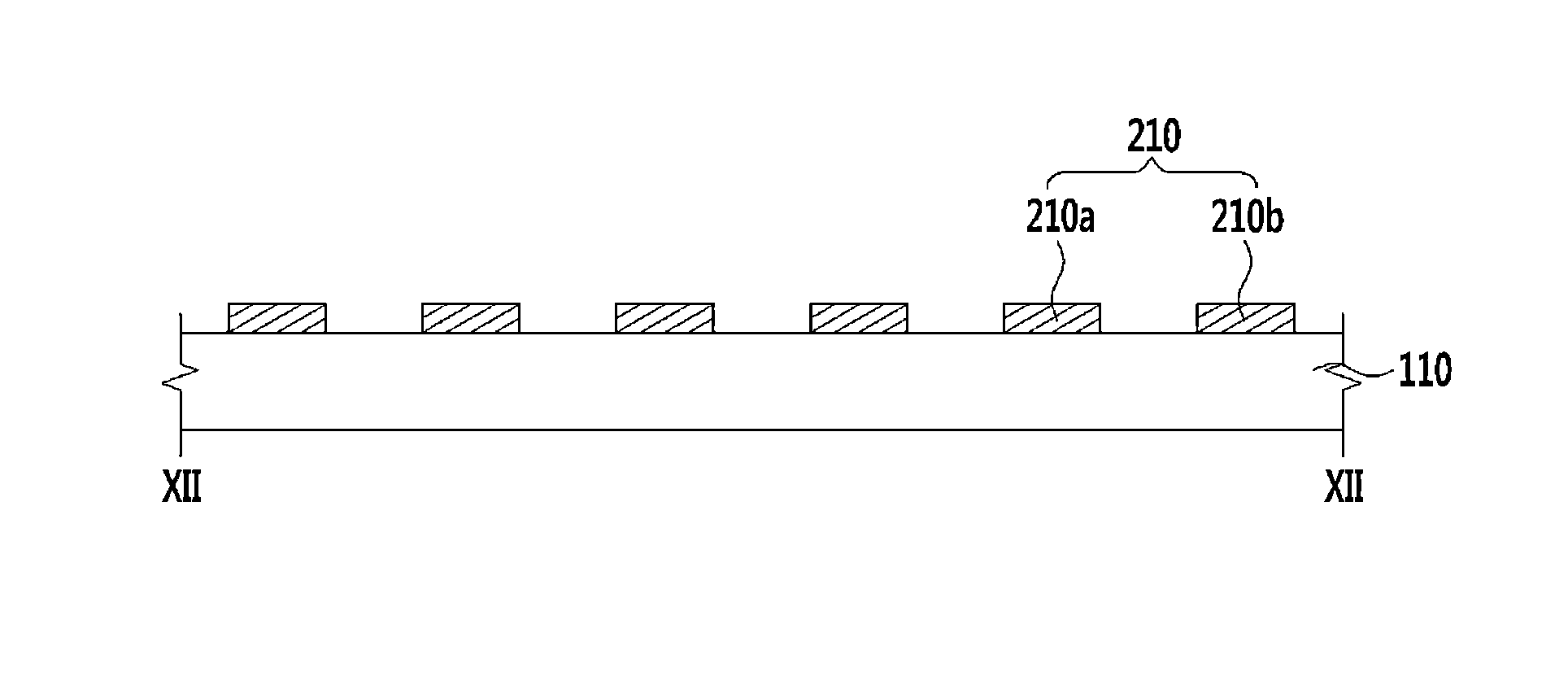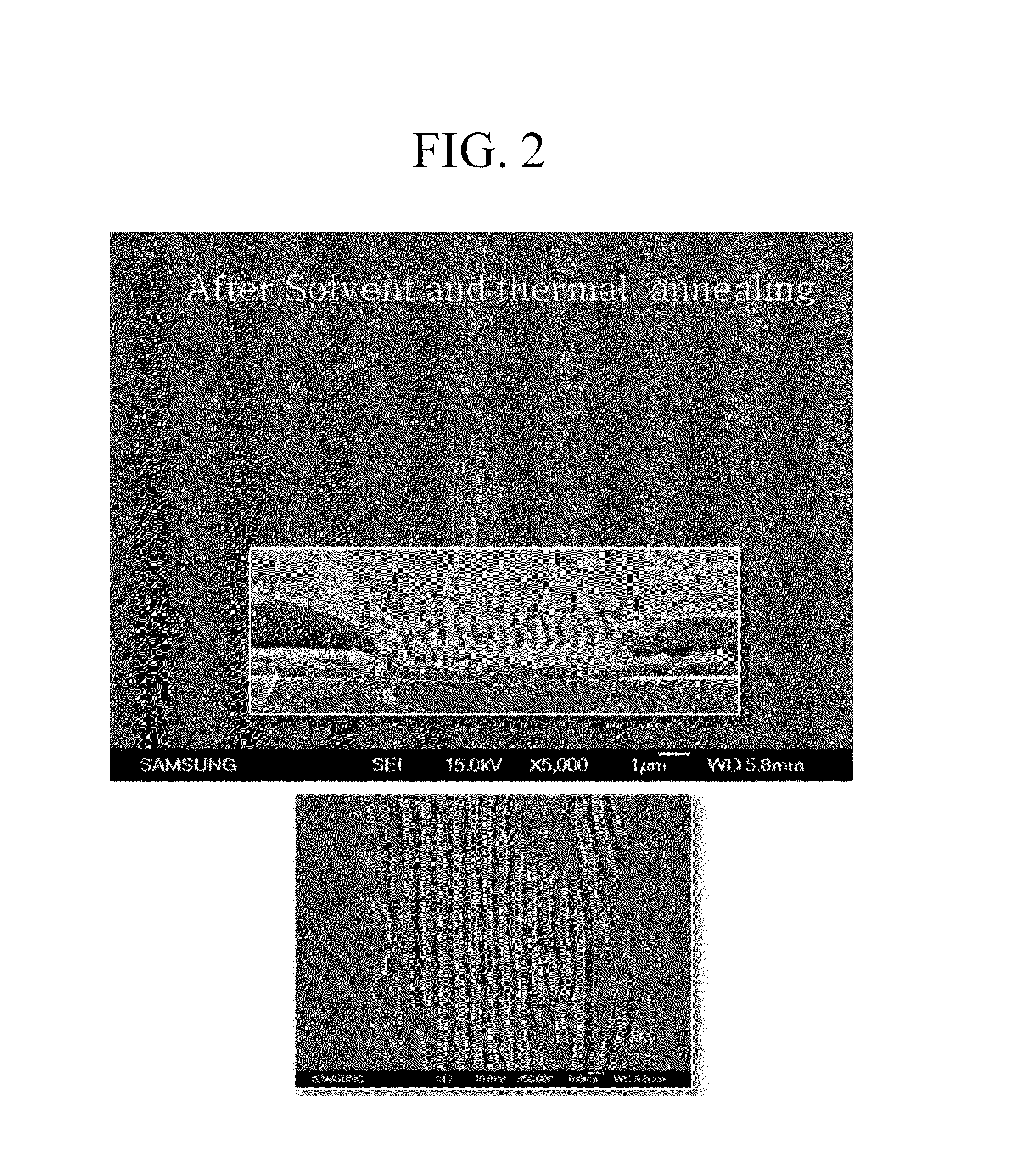Block copolymer, method of forming the same, and method of forming pattern
a technology of block copolymer and pattern, which is applied in the direction of decoration arts, footwear, apparel, etc., can solve the problem of difficulty in providing a pattern having a period of more than 100 nm from a self-assembly process, and achieve the effect of reducing the process time for forming a pattern by using such a block copolymer, reducing the difficulty of self-assembly process, and increasing the phase separation speed
- Summary
- Abstract
- Description
- Claims
- Application Information
AI Technical Summary
Benefits of technology
Problems solved by technology
Method used
Image
Examples
experimental example 1
[0083]A neutralization layer is formed on a silicon substrate, and the bottle-brush type block copolymer comprising a first block represented by Formula 1 and a second block represented by Formula 2 is mixed with propylene glycol methyl ethyl acetate (“PGMEA”) to prepare a solution containing 5 wt % of the block copolymer. The solution is coated on the neutralization layer. Next, solvent annealing is performed for 40 minutes at a temperature of 21° C. Next, a heat treatment (thermal annealing) is performed for 60 minutes at a temperature of 240° C.
[0084]Referring to FIG. 1, FIG. 1 is a vertical lamella structure of the block copolymer having random directivity. It may be confirmed that phase-separation of the block copolymer is achieved.
experimental example 2
[0085]After forming the neutralization layer as described in Experimental Example 1, guide patterns having a width of about 1.5 μm are formed, and the bottle-brush type of block copolymer comprising a first block represented by Formula 1 and a second block represented by Formula 2 is coated between the guide patterns. The rest of the process is performed the same as in Experimental Example 1.
[0086]Referring to FIG. 2, FIG. 2 is a vertical lamella structure of a nanoline shape aligned between a guided pattern. It may be confirmed that the phase-separation of the block copolymer is generated thereby forming a linear pattern well.
[0087]Next, a block copolymer according to another exemplary embodiment will be described, in particular a linear block copolymer embodiment is described.
[0088]The linear block copolymer according to an exemplary embodiment of the present disclosure includes a first block represented by COM A in Structural Formula A, a second block represented by COM B in Stru...
experimental example 3
[0100]FIG. 5 shows a vertical lamella structure having random directivity.
[0101]A neutralization layer is formed on a silicon substrate, and three samples of the block copolymer, of which a volume fraction of the random block is respectively 8%, 12%, and 15% in the three samples is mixed with the PGMEA and is coated on the neutralization layer. Next, thermal annealing is performed for 12 hours at a temperature of 250° C. As a result, compared with the linear block copolymer without the random block, the period (i.e., distance between the repetition of the physical structure) is respectively increased by 28%, 67%, and 70%.
[0102]FIG. 5 shows a phase-separation phenomenon in which the linear block copolymer of which the volume fraction of the random block is 8% is thermal-treated, and it may be confirmed that the phase-separation of the block copolymer is generated well.
PUM
| Property | Measurement | Unit |
|---|---|---|
| size | aaaaa | aaaaa |
| temperature | aaaaa | aaaaa |
| temperature | aaaaa | aaaaa |
Abstract
Description
Claims
Application Information
 Login to View More
Login to View More - R&D
- Intellectual Property
- Life Sciences
- Materials
- Tech Scout
- Unparalleled Data Quality
- Higher Quality Content
- 60% Fewer Hallucinations
Browse by: Latest US Patents, China's latest patents, Technical Efficacy Thesaurus, Application Domain, Technology Topic, Popular Technical Reports.
© 2025 PatSnap. All rights reserved.Legal|Privacy policy|Modern Slavery Act Transparency Statement|Sitemap|About US| Contact US: help@patsnap.com



